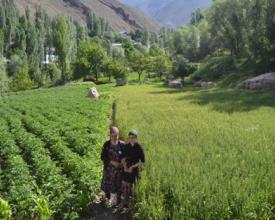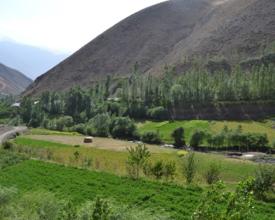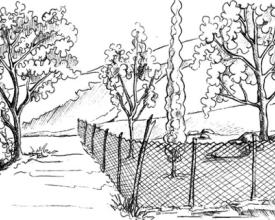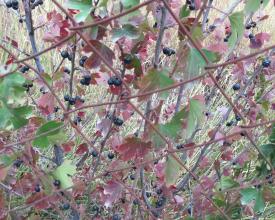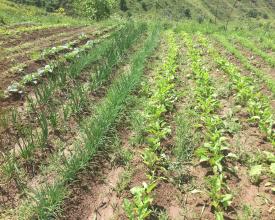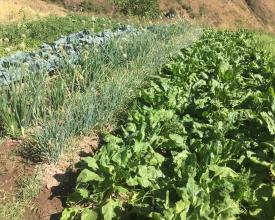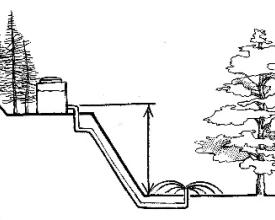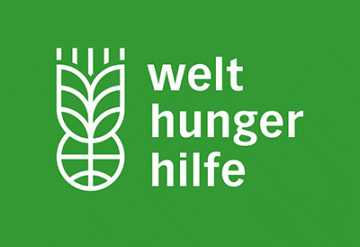
Cultures annuelles irriguées gérées durablement
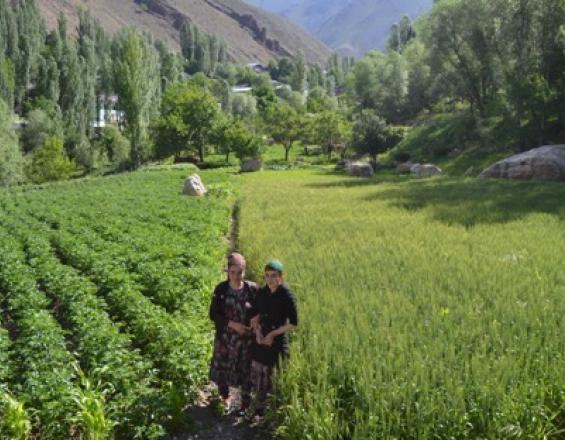
Environ 95 % de la production de cultures de base au Tadjikistan provient de terres irriguées, ce qui souligne l'importance de l'irrigation pour les cultures agricoles annuelles.
La productivité des cultures annuelles irriguées dépend largement de la fourniture de services écosystémiques, tels que la pollinisation, l'eau et la fertilité des sols.
Les cultures annuelles irriguées sont généralement des cultures intensives qui utilisent efficacement les ressources foncières et constituent des écosystèmes artificiels qui ne peuvent pas contribuer au maintien et à l'amélioration de la biodiversité et des services écosystémiques. Au contraire, elles se concentrent principalement sur l'application d'énormes quantités d'intrants chimiques et, dans de nombreux cas, utilisent l'eau de manière inefficace.
Les cultures annuelles irriguées gérées de manière durable se concentrent sur la réduction des semences hybrides, des engrais chimiques et des pesticides synthétiques.
Contexte
Défis à relever
La promotion des cultures annuelles irriguées pose les défis suivants :
- La préparation traditionnelle du sol pour les cultures annuelles, qui consiste à labourer la terre, est gourmande en ressources et nécessite une grande quantité d'intrants tels que des engrais et des pesticides.
- Les systèmes d'irrigation nécessitent non seulement des infrastructures spécialisées, mais aussi une gestion appropriée qui réduit l'érosion et la salinisation des sols.
- En outre, la menace de températures élevées et de faibles précipitations est concrète et associée au changement climatique.
Emplacement
Traiter
Résumé du processus
Les clôtures sont la condition préalable pour garantir que les cultures annuelles irriguées ne seront pas détruites par les animaux domestiques.
Le labour en courbes de niveau empêche l'érosion du sol et préserve ainsi la fertilité du sol, ce qui est une condition pour obtenir une bonne récolte des cultures annuelles.
Le labour en courbes de niveau et les techniques d'irrigation économes en eau améliorent l'approvisionnement en eau des cultures, ce qui permet d'obtenir une meilleure récolte.
Blocs de construction
Clôture
En raison des grands troupeaux de bétail, il est souvent nécessaire de clôturer les cultures annuelles, en particulier si les champs cultivés sont situés à proximité de routes ou de couloirs pour le bétail. Il existe plusieurs formes de clôtures au Tadjikistan. Les clôtures en grillage sont efficaces mais coûteuses. Contrairement aux clôtures naturelles, les clôtures en fil de fer ne génèrent pas de revenus supplémentaires grâce aux récoltes de fruits ou de bois.
Dans la mesure du possible, il convient d'utiliser des matériaux naturels locaux (par exemple des branches, des broussailles, des pierres, des bâtons de bois, etc. Ces matériaux sont moins chers que le grillage ou le béton et offrent des habitats aux insectes utiles et aux autres pollinisateurs. Les clôtures vivantes constituées d'arbres et de buissons locaux, de préférence avec des épines (aubépine, prunier-cerise et épine-vinette), sont encore plus appropriées car elles contribuent à la biodiversité et fournissent du bois de chauffage et des fruits sauvages. Elles peuvent toutefois nécessiter une protection et un arrosage au cours des premières années.
Si des pierres sont disponibles sur le site, il est également possible d'envisager une clôture avec des murs en pierre. Les murs en pierre naturelle sont non seulement durables, mais ils créent également des habitats pour les pollinisateurs, les autres insectes et les petits mammifères.
Facteurs favorables
De nombreux agriculteurs doivent constamment s'inquiéter de voir leurs champs pénétrés par le bétail en route vers les pâturages d'été, ce qui crée des conflits au sein de la communauté et avec les bergers. En clôturant leurs champs, les membres de la famille sont déchargés de cette tâche inquiétante de surveillance des parcelles et peuvent consacrer leur temps à des tâches plus efficaces.
Leçon apprise
Des clôtures sont nécessaires sur la plupart des champs de cultures annuelles irriguées et les agriculteurs sont prêts à apporter leur propre contribution pour clôturer leurs parcelles. Cela a bien fonctionné lorsque le projet a fourni le grillage et que les agriculteurs ont apporté les bâtons et la main d'œuvre nécessaires à l'installation de la clôture. Cependant, l'équipe du projet recommande de piloter des mécanismes de clôture durables ou des micro-crédits afin de réduire la dépendance aux intrants du projet et donc d'atteindre plus d'agriculteurs.
Labour en courbes de niveau
Le labour en courbes de niveau doit être utilisé dans les zones à forte pente. La terre est labourée perpendiculairement à la pente, le long des courbes de niveau qui s'incurvent autour de la terre arable. Les courbes de niveau favorisent l'infiltration de l'eau de pluie car l'écoulement de l'eau est stoppé. Ainsi, le risque d'érosion du sol et de formation de ravines est réduit et la disponibilité de l'eau pour les cultures annuelles est accrue. L'effet de conservation du sol des courbes de niveau peut être renforcé par la plantation de bandes herbeuses, de buissons ou de haies le long de celles-ci.
Facteurs favorables
Les cultures agricoles souffrent de plus en plus du changement climatique au Tadjikistan, qui se manifeste notamment par une modification du régime des précipitations et des températures plus élevées pendant les mois d'été, ce qui accroît le stress hydrique des plantes. Le labourage en courbes de niveau permet d'améliorer l'infiltration de l'eau de pluie, ce qui augmente la réserve d'eau disponible dans le sol et garantit un meilleur développement des cultures annuelles.
Leçon apprise
De nombreux agriculteurs sont convaincus que le labourage en courbes de niveau est une mesure adéquate pour réduire l'érosion des sols et augmenter la disponibilité de l'eau pour leurs cultures. Cependant, la plupart d'entre eux ne possèdent pas de tracteur et doivent faire appel à des prestataires de services agricoles pour préparer leurs terres. Souvent, ces derniers ne labourent pas en suivant les courbes de niveau, sous prétexte que cela prend du temps et endommage leur moteur. Une solution possible serait que les agriculteurs intéressés par le labour en courbes de niveau achètent des tracteurs à un seul essieu, qui sont relativement abordables et qui leur permettront de labourer en courbes de niveau par eux-mêmes.
Cultures intercalaires
La culture intercalaire est une technique de plantation qui consiste à cultiver deux ou plusieurs plantes en même temps sur le même champ. Les cultures associées doivent appartenir à des familles de plantes différentes, afin de ne pas partager les mêmes parasites et maladies et d'avoir des exigences différentes en matière de fertilité du sol et d'éléments nutritifs et de les extraire de différents horizons du sol. Les cultures intercalaires créent une biodiversité qui attire les insectes bénéfiques et prédateurs. Comme la floraison augmente, les cultures intercalaires favorisent également les insectes pollinisateurs et donc l'apiculture.
Il existe trois classifications de base pour les cultures intercalaires : a) la culture mixte, qui consiste à planter une variété de plantes compatibles ensemble sans aucun arrangement défini (par exemple, du maïs planté avec des haricots) ; b) la culture en rangs ou en couloirs, dans laquelle différentes cultures sont plantées les unes à côté des autres en rangs (par exemple, des carottes alternées avec des haricots) ; c) la culture en bandes, dans laquelle différentes cultures sont plantées les unes à côté des autres en rangs.carottes et oignons en rangées alternées) ; c) la culture intercalaire temporelle, dans laquelle une culture à croissance lente est plantée avec une culture à croissance plus rapide, qui est récoltée plus tôt, ce qui permet à la culture à croissance lente d'occuper ensuite toute la surface de plantation (par exemple, pommes de terre et citrouilles).
Facteurs favorables
Les cultures intercalaires augmentent la diversité des produits à récolter et réduisent le risque de perte totale de la récolte à cause des ravageurs et des maladies, car ceux-ci sont normalement spécifiques à l'hôte.
Les cultures intercalaires maintiennent la fertilité du sol, car les éléments nutritifs ne sont pas épuisés unilatéralement.
Les cultures intercalaires augmentent la biodiversité et attirent ainsi les insectes bénéfiques et prédateurs.
Grâce à la diversification des cultures, la saison de floraison est prolongée, ce qui est favorable à l'apiculture.
Leçon apprise
Les agriculteurs du Tadjikistan ont tendance à planter des cultures trop étroites, ce qui entraîne des interférences négatives entre les cultures ; les plus faibles sont supprimées, la récolte par plante est plus faible et partielle, et le potentiel de la culture intercalaire n'est pas exploité de manière adéquate. Lors de la culture intercalaire, il faut s'assurer que chacune des espèces concernées dispose d'un espace suffisant pour se développer.
La demande en eau des cultures associées doit être similaire afin de fournir suffisamment d'eau à chacune des espèces.
Les agriculteurs sont parfois sceptiques à l'égard des cultures intercalaires, estimant qu'il sera difficile de séparer les produits, par exemple l'avoine et les pois. Par conséquent, des mécanismes adéquats, tels que l'utilisation de différents tamis pour séparer les grains, doivent être présentés aux agriculteurs.
Techniques d'irrigation économes en eau
L'irrigation par gravité (irrigation par sillons ou irrigation de surface) est la principale technique d'irrigation utilisée au Tadjikistan pour les cultures annuelles. Afin d'éviter l'érosion, l'irrigation doit se faire par des sillons qui suivent des courbes de niveau légèrement inclinées. L'afflux d'eau doit être lent, afin d'augmenter l'infiltration de l'eau dans le sol et de réduire le risque d'érosion le long du sillon d'irrigation. En outre, des mesures doivent être mises en œuvre pour rendre l'irrigation par gravité plus efficace, par exemple en recouvrant les canaux d'irrigation d'un film plastique pour réduire la perte d'eau par infiltration ou en distribuant l'eau dans les sillons au moyen de tuyaux en plastique pour obtenir une répartition homogène.
Une attention particulière doit être portée pour éviter un arrosage excessif ; l'eau en excès doit être évacuée correctement car elle peut provoquer l'érosion du sol, la formation de rigoles ou attirer les parasites.
Dans un système d'irrigation par gravité, il est essentiel de briser la surface du sol entre les sillons afin de détruire les capillaires et de préserver ainsi l'humidité.
Des techniques d'irrigation plus sophistiquées et plus efficaces, telles que l'irrigation au goutte-à-goutte et par aspersion, ne sont pas économiquement viables dans la plupart des cas pour les cultures irriguées annuelles.
Facteurs favorables
L'eau est une ressource rare au Tadjikistan et la situation s'aggrave avec la croissance démographique et le changement climatique. C'est pourquoi les agriculteurs souhaitent mettre en œuvre des techniques d'irrigation permettant d'économiser l'eau. Le moyen de prédilection est l'amélioration de l'irrigation par gravité, car dans la plupart des cas, il est trop coûteux d'installer des systèmes d'irrigation au goutte-à-goutte ou par aspersion pour les cultures annuelles.
Leçon apprise
De nombreux agriculteurs irriguent les cultures annuelles par gravité, en laissant l'eau s'écouler vers le bas de la pente, sans savoir qu'une telle procédure provoque l'érosion. Ils devraient être formés à l'irrigation par sillons en suivant les courbes de niveau.
Impacts
Les cultures annuelles sont importantes pour générer des revenus, assurer la sécurité alimentaire et, si elles sont diversifiées, la sécurité nutritionnelle.
Les systèmes agricoles intensifs sont généralement moins aptes à absorber les chocs et présentent un risque plus élevé de parasites. L'approche décrite ici rendra la production plus résistante aux chocs et aux changements climatiques. En outre, la diversification des champs de cultures annuelles améliore la diversité biologique des plantes et des insectes, réduit le besoin et la dépendance à l'égard des systèmes d'irrigation et a moins d'effets négatifs sur les écosystèmes adjacents. En outre, la dégradation et l'érosion des sols peuvent être réduites et la fertilité des sols peut être améliorée grâce à des techniques de labourage faible ou nul et à la rotation des cultures.
Bénéficiaires
Les bénéficiaires de cette approche sont les agriculteurs désireux de pratiquer des cultures irriguées de manière à contribuer à la conservation et à la promotion de la biodiversité et des services écosystémiques.
Histoire
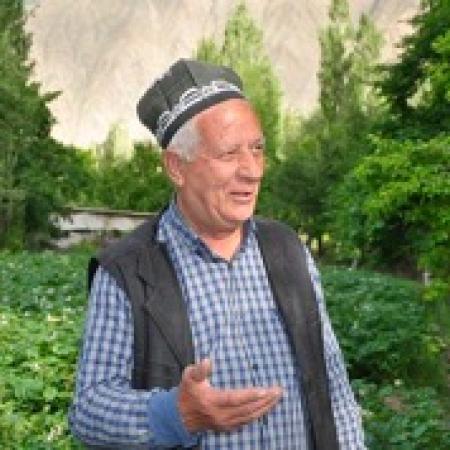
La porte du mur de pierre qui entoure l'ensemble de la zone est ouverte et révèle un jardin verdoyant sous des arbres fruitiers ombragés. Le propriétaire de ce jardin, situé dans le village de Pokhut, dans la vallée de Zerafshan, au nord du Tadjikistan, est Azim Choragabov. Il est âgé de 65 ans. Le Tadjikistan étant principalement recouvert de hautes montagnes, l'agriculture est limitée aux vallées. Le changement climatique entraîne de fréquentes sécheresses et coulées de boue qui mettent en péril les récoltes et provoquent l'insécurité alimentaire et la malnutrition. Même dans ces conditions difficiles, l'agriculture est la principale source de revenus pour la population croissante du Tadjikistan, et aussi pour Azim. Lorsqu'il se promène dans les champs, il passe doucement ses doigts dans les pommes de terre en fleur et se souvient de lui-même il y a quelques temps : "Avant, je me laissais aller et je consommais tout sans réfléchir. Je perdais ainsi mon temps. Puis j'ai perdu mon fils il y a quelques années. Après cela, j'ai cherché à mieux comprendre la vie et j'ai pris conscience de sa valeur intérieure."
Cette prise de conscience l'a amené à modifier non seulement son propre comportement, mais aussi son attitude à l'égard de son environnement. Azim est devenu plus attentif aux variétés de plantes locales et a montré un intérêt accru pour leurs qualités et avantages spécifiques. C'est à ce moment-là qu'Azim a décidé de s'impliquer et de participer au projet "Biodiversité et services écosystémiques dans les paysages agricoles". Avec les semences fournies par Welthungerhilfe, Azim cultive un mélange de plantes : pommes de terre, haricots, calendula, blé, citrouille - et haricot d'Inde. "Autrefois, les gens utilisaient beaucoup le haricot d'Inde, qui aide à lutter contre le diabète. J'ai recommencé à le cultiver pour le partager avec les voisins et le vendre".
Il prévoit d'apporter les haricots qu'il cultive à la banque de semences qui sera créée dans le cadre de ce projet.
Aujourd'hui, lorsqu'il est dans son potager, Azim est totalement absorbé par ce qu'il fait. C'est un homme serein, richement doté en calme et en sérénité. Parfois, on a l'impression qu'il écoute ses plantes et ses fleurs. Et il transmet ses connaissances et son amour pour la culture des plantes locales à ses six enfants qui l'aident dans le jardin. Pendant que ses petits-enfants jouent dans le jardin, il affronte l'avenir avec confiance et espoir.
